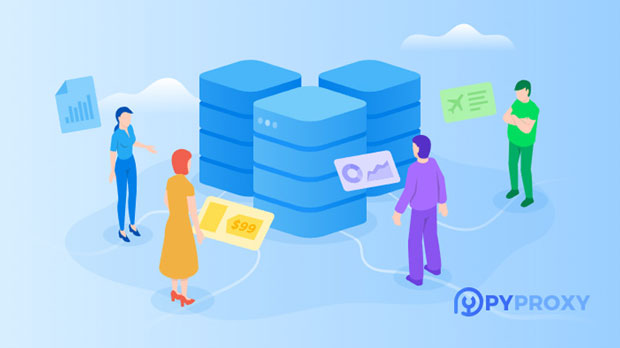When choosing between PYPROXY and Proxy-Seller, the primary factor often boils down to usability. Both platforms are popular for their proxy services, yet each offers unique features that cater to different user needs. For individuals or businesses requiring proxies for web scraping, bypassing geo-restrictions, or conducting market research, the usability of the platform plays a key role in enhancing the overall experience. This article will compare the two platforms, evaluating their user interface, ease of setup, customer support, pricing, and additional functionalities, to determine which one provides superior usability. 1. Introduction to Pyproxy and Proxy-SellerPyproxy and Proxy-Seller are platforms that provide proxy services, allowing users to maintain anonymity and perform activities like web scraping and accessing restricted content. Both platforms have gained recognition for their reliability and performance in providing proxies, but the way they present their services and assist their customers differ.Pyproxy focuses on delivering a seamless proxy experience through an intuitive interface, while Proxy-Seller is designed for users looking for flexibility and a wide range of proxy types. In terms of usability, the platforms differentiate themselves through their design, pricing models, and customer support systems, all of which play a critical role in the user experience.2. User Interface: Simplicity vs. CustomizationThe first aspect to consider when comparing usability is the user interface (UI). A clean, straightforward interface makes it easier for users to navigate the platform, especially for beginners who might not have technical expertise.Pyproxy: Pyproxy boasts a minimalistic and simple UI that prioritizes ease of use. Upon logging in, users are presented with a dashboard that immediately shows their active proxies, usage statistics, and settings. This no-frills approach makes it ideal for individuals who want a hassle-free experience. The platform's simplicity can be seen as its greatest strength, especially for those who do not require complex configurations.Proxy-Seller: Proxy-Seller, on the other hand, offers more customization options. The dashboard is slightly more complicated, with additional tabs and settings for advanced users. This complexity might be intimidating for someone new to proxies, but it provides greater flexibility for seasoned users who need to fine-tune their proxy settings. Overall, Proxy-Seller’s UI is designed to cater to both beginners and experienced users, but the learning curve is steeper compared to Pyproxy.3. Ease of Setup and IntegrationSetting up proxies can sometimes be a challenging task, especially for people without technical knowledge. A platform’s ability to simplify the setup process directly impacts its usability.Pyproxy: Pyproxy shines in this regard due to its straightforward setup process. Users can quickly obtain proxies and set them up with minimal effort. The platform offers easy-to-follow guides and automated systems that ensure users are up and running within minutes. This makes Pyproxy highly suitable for individuals or businesses who need proxies in a hurry without dealing with complex configurations.Proxy-Seller: Proxy-Seller offers a similar setup process, but it’s more detailed. For users with specific requirements (e.g., rotating proxies, residential proxies), the setup may require additional steps. While this could be an advantage for advanced users who need tailored setups, it might overwhelm beginners. However, Proxy-Seller offers documentation and customer support that assist in simplifying the process for all users.4. Customer Support and AssistanceEffective customer support is a crucial part of usability. If a platform’s support team is responsive and knowledgeable, users are more likely to have a smooth experience, especially when facing technical difficulties.Pyproxy: Pyproxy offers robust customer support with live chat, email, and a dedicated support portal. The team is responsive and provides clear, concise solutions to common issues. The platform also features a knowledge base with troubleshooting guides that allow users to solve basic problems independently. Overall, Pyproxy’s customer service is responsive and efficient, which enhances its usability.Proxy-Seller: Proxy-Seller also provides 24/7 customer support, but it offers a broader range of assistance options. In addition to live chat and email, Proxy-Seller has a ticket-based system that allows users to submit specific issues. The team is highly knowledgeable and can assist with complex proxy configurations. However, response times may be longer due to the more technical nature of the queries.5. Pricing and Value for MoneyThe pricing model plays a significant role in determining the overall usability of a platform. If a service is too expensive or lacks flexible payment options, users may find it difficult to justify its use.Pyproxy: Pyproxy’s pricing is relatively simple and affordable. It offers a tiered pricing structure based on the number of proxies and the level of service required. The platform is ideal for users who don’t require a vast number of proxies and prefer straightforward billing. The pricing transparency and predictable costs make it a user-friendly option for individuals or small businesses.Proxy-Seller: Proxy-Seller’s pricing is more flexible and caters to users with varying needs. It offers more options, such as pay-as-you-go models and subscription plans, depending on the number of proxies needed. While this flexibility is an advantage for businesses that require large-scale proxy services, it can make it difficult for casual users to estimate costs. The platform’s pricing structure is well-suited for large enterprises but might be more complex for smaller users.6. Proxy Types and Additional FeaturesIn addition to the basic functionality, the range of proxy types and features offered by each platform can greatly affect its usability.Pyproxy: Pyproxy is somewhat limited in terms of the variety of proxies it offers. It focuses primarily on residential proxies, which are sufficient for general use cases such as web scraping or accessing geo-blocked content. The platform’s simplicity and ease of use make it an attractive choice for individuals who need proxies without requiring advanced features.Proxy-Seller: Proxy-Seller, however, offers a wider selection of proxies, including residential, datacenter, and rotating proxies. This variety gives users more flexibility in their choice of proxy type. For users with specific needs, such as anonymous browsing or high-volume scraping, Proxy-Seller’s additional options make it a more versatile choice. These extra features come at a cost, however, as they require more configuration and understanding.7. Conclusion: Which Platform is More User-Friendly?In conclusion, both Pyproxy and Proxy-Seller have their strengths and weaknesses in terms of usability. Pyproxy stands out for its simplicity, clean design, and straightforward setup process, making it the better choice for casual users or small businesses with basic proxy needs. It excels in providing an easy-to-navigate platform with responsive customer support.On the other hand, Proxy-Seller offers greater flexibility, a wider variety of proxy types, and more customization options, which are ideal for users with more complex needs. While its user interface may be slightly more complicated, it provides robust features that can benefit advanced users.Ultimately, the choice between Pyproxy and Proxy-Seller depends on the user's requirements. If you prioritize simplicity and ease of use, Pyproxy is the better option. If you need more advanced features and customization, Proxy-Seller offers more options for a larger range of use cases.
Aug 08, 2025


































































